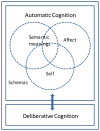A Cognitive-Social Model of Fertility Intentions
- PMID: 25132695
- PMCID: PMC4132897
- DOI: 10.1111/j.1728-4457.2013.00612.x
A Cognitive-Social Model of Fertility Intentions
Abstract
We examine the use and value of fertility intentions against the backdrop of theory and research in the cognitive and social sciences. First, we draw on recent brain and cognition research to contextualize fertility intentions within a broader set of conscious and unconscious mechanisms that contribute to mental function. Next, we integrate this research with social theory. Our conceptualizations suggest that people do not necessarily have fertility intentions; they form them only when prompted by specific situations. Intention formation draws on the current situation and on schemas of childbearing and parenthood learned through previous experience, imbued by affect, and organized by self-representation. Using this conceptualization, we review apparently discordant knowledge about the value of fertility intentions in predicting fertility. Our analysis extends and deepens existing explanations for the weak predictive validity of fertility intentions at the individual level and provides a social-cognitive explanation for why intentions predict as well as they do. When focusing on the predictive power of intentions at the aggregate level, our conceptualizations lead us to focus on how social structures frustrate or facilitate intentions and how the structural environment contributes to the formation of reported intentions in the first place. Our analysis suggests that existing measures of fertility intentions are useful but to varying extents and in many cases despite their failure to capture what they seek to measure.
Figures
References
-
- Abma Joyce, Chandra Anjani, Mosher William D, Peterson Linda, Piccinino Linda. Fertility, family planning, and women’s health: New data from the 1995 National Survey of Family Growth. National Center for Health Statistics. Vital Health Stat. 23(19) - PubMed
-
- Bachrach Christine A, Philip Morgan S. Further Reflections on the Theory of Planned Behavior and Fertility Research. Vienna Yearbook of Population Research. 2011;9:71–74.
-
- Bandura Albert. Social Learning Theory. Morristown, NJ: General Learning Press; 1977.
-
- Barber Jennifer S. Ideational influences on the transition to parenthood: Attitudes toward childbearing and competing alternatives. Social Psychology Quarterly. 2001;64(2):101–127.
Grants and funding
LinkOut - more resources
Full Text Sources
Other Literature Sources



